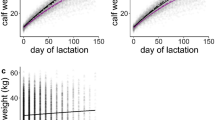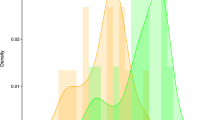Abstract
In undomesticated animals information about the production and composition of milk over time is still scarce. In general, for most mammals it is known that milk composition changes across lactation, is different for male and female offspring, and even that marsupials, such as kangaroos, can simultaneously produce milk of different compositions for young of different ages. Such parallel milk production of differing compositions has not yet been studied in single-offspring placental mammals, but may help to explain behavioural processes like allosuckling (feeding the young of other adults) and lateralized suckling preferences. In this study we analysed the production and composition of milk in red deer throughout the lactation period and now confirm for the first time that there are axial differences present. The front teats, which are the favoured suckling positions of the deer’s offspring, produce milk with a greater protein-to-fat ratio. Also, from the beginning of lactation the yield is greater on the left side, the side preferred by calves in all of the studied species, both at population and individual level. The links between milk production and calf behaviour in deer deserve further study.




Similar content being viewed by others
References
Oftedal OT. Milk composition, milk yield and energy output at peak lactation: a comparative review. Symp Zool Soc Lond. 1994;51:33–85.
Loudon ASI, Kay RNB. Lactational constraints on a seasonally breeding mammal: the red deer. Symp Zool Soc Lond. 1984;51:233–52.
Auldist MJ, Walsh BJ, Thomson NA. Seasonal and lactational influences on bovine milk composition in New Zealand. J Dairy Res. 1998;65:401–11.
Landete-Castillejos T, Garcia AJ, Lopez-Serrano FR, Gallego L. Maternal quality and differences in milk production and composition for male and female Iberian red deer calves (Cervus elaphus hispanicus). Behav Ecol Sociobiol. 2005;57:267–74.
Hinde K. First time macaque mothers bias milk composition in favor of sons. Curr Biol. 2007;17:958–9.
Hinde K. Richer milk for sons but more milk for daughters: sex-biased investment during lactation varies with maternal life history in rhesus macaques. Am J Human Biol. 2009;21:512–9.
Hinde K, Foster AB, Landis LM, Rendina D, Oftedal OT, Power ML. Daughter dearest: sex-biased calcium in mother's milk among rhesus macaques. Am J Phys Anthropol. 2013;151:144–50.
Robert KA, Braun S. Milk composition during lactation suggests a mechanism for male biased allocation of maternal resources in the tammar wallaby (Macropus eugenii). PLoS One. 2012;7:e51099.
Gallego L, Gomez JA, Landete-Castillejos T, Garcia AJ, Estevez JA, Ceacero F, Piñeiro V, Casabiell X, de la Cruz LF. Effect of milk minerals on calf gains and sex differences in mineral composition of milk from Iberian red deer (Cervus elaphus hispanicus). Reproduction. 2009;138:859–65.
Powe CE, Knott CD, Conklin-Brittain N. Infant sex predicts breast milk energy content. Am J Human Biol. 2010;22:50–4.
Trott JF, Simpson KJ, Moyle RL, Hearn CM, Shaw G, Nicholas KR, Renfree MB. Maternal regulation of milk composition, milk production, and pouch young development during lactation in the tammar wallaby (Macropus eugenii). Biol Reprod. 2003;68:929–36.
Wu WZ, Wang XQ, Wu GY, Kim SW, Chen F, Wang JJ. Differential composition of proteomes in sow colostrum and milk from anterior and posterior mammary glands. J Anim Sci. 2010;88:2657–64.
Jacobsen KL, DePeters EJ, Rogers QR, Taylor SJ. Influences of stage of lactation, teat position and sequential milk sampling on the composition of domestic cat milk (Felis catus). J Anim Physiol Anim Nutr. 2004;88:46–58.
Arteaga L, Rödel HG, Elizalde MT, Gonzalez D, Hudson R. The pattern of nipple use before weaning among littermates of the domestic dog. Ethology. 2013;119:12–9.
Nishida T. Left nipple suckling preference in wild chimpanzees. Ethol Sociobiol. 1993;14:45–51.
Tomaszycki M, Cline C, Griffin B, Maestripieri D, Hopkins WD. Maternal cradling and infant nipple preferences in rhesus monkeys (Macaca mulatta). Dev Psychobiol. 1998;32:305–12.
Damerose E, Hopkins WD. Scan and focal sampling: reliability in the laterality for maternal cradling and infant nipple preferences in olive baboons, Papio anubis. Anim Behav. 2002;63:511–8.
Hopkins WD, De Lathouwers M. Left nipple preferences in infant Pan paniscus and P. troglodytes. Int J Primat. 2006;27:1653–62.
Gero S, Whitehead H. Suckling behavior in sperm whale calves: observations and hypotheses. Mar Mammal Sci. 2007;23:398–413.
Pluháček J, Olléová M, Bartošová J, Pluháčková J, Bartoš L. Laterality of suckling behaviour in three zebra species. Laterality. 2013;18:349–64.
Komárková M, Bartošová J. Lateralized suckling in domestic horses (Equus caballus). Anim Cogn. 2013;16:343–9.
Landete-Castillejos T, Garcia AJ, Molina P, Vergara H, Garde J, Gallego L. Milk production and composition in captive Iberian red deer (Cervus elaphus hispanicus): effect of birth date. J Anim Sci. 2000;78:2771–7.
Brelerut A, Pingard A, Thériez M. Le cerf et son élevage. INRA; 1990.
Landete-Castillejos T, Molina P, Garcia A, Gomez JA, Gallego L. Estimate and production of milk energy in two subspecies of red deer: Cervus elaphus hispanicus and C. e. scoticus. J Exp Zool Part A. 2003;300:152–7.
Landete-Castillejos T, Garcia A, Gallego L. Calf growth in captive Iberian red deer (Cervus elaphus hispanicus): effect of birth date and hind milk production and composition. J Anim Sci. 2001;79:1085–92.
Arman P. Parturition and lactation in red-deer. J Br Deer Soc. 1974;3:222–4.
Bartoš L, Vaňková D, Hyánek J, Šiler J. Impact of allosucking on growth of farmed red deer calves (Cervus elaphus). Anim Sci. 2001;72:493–500.
Landete-Castillejos T, Garcia A, Garde J, Gallego L. Milk intake and production curves and allosuckling in captive Iberian red deer, Cervus elaphus hispanicus. Anim Behav. 2000;60:679–87.
Ceacero F, Landete-Castillejos T, García AJ, Estévez JA, Gaspar-López E, Olguín CA, López-Parra JE, Gallego L. Influencia del entorno social en la frecuencia y éxito de aloamamantamientos en ciervo ibérico. 34 Congreso Nacional de la Sociedad Española de Ovinotecnia y Caprinotecnia. Barbastro (Spain), September 16th to 19th, 2009. Libro de Resúmenes, 593–595.
Drábková J, Bartošová J, Bartoš L, Kotrba R, Pluháček J, Švecová L, Dušek A, Kott T. Sucking and allosucking duration in farmed red deer (Cervus elaphus). Appl Anim Behav Sci. 2008;113:215–23.
Trivers RL. Parent-offspring conflict. Am Zool. 2001;14:249–64.
Peaker M. The mammary gland in mammalian evolution: a brief commentary on some of the concepts. J Mammary Gland Biol. 2002;7:347–53.
Koprowski JA, Tucker HA. Serum prolactin during various physiological states and its relationship to milk production in the bovine. Endocrinology. 1973;92:1480–7.
Peaker M, Wilde CJ. Feedback control of milk secretion from milk. J Mammary Gland Biol. 1996;1:307–15.
Ben-Jonathan N, Mershon JL, Allen DL, Steinmetz RW. Extrapituitary prolactin: distribution, regulation, functions, and clinical aspects. Endocr Rev. 1996;17:639–69.
Horseman ND. Prolactin and mammary gland development. J Mammary Gland Biol. 1999;4:79–88.
Wilde CJ, Addey CV, Boddy LM, Peaker M. Autocrine regulation of milk secretion by a protein in milk. Biochem J. 1995;305:51–8.
Rothschild MF, Bodoh GW, Pearson RE, Miller RH. Sources of variation in quarter milk flow measures. J Dairy Sci. 1980;63:1138–44.
Johansson I, Korkman N. Heritability of the udder proportions in dairy cows. Hereditas. 1952;38:131–51.
Tančin V, Ipema B, Hogewerf P, Mačuhová J. Sources of variation in milk flow characteristics at udder and quarter levels. J Dairy Sci. 2006;89:978–88.
Drewett RF, Woolridge M. Milk intake by human babies from the first and second breast. Physiol Behav. 1981;26:327–9.
Hsieh CC, Trichopoulos D. Breast size, handedness and breast cancer risk. Eur J Cancer. 1991;27:131–5.
Senie RT, Saftlas AF, Brinton LA, Hoover RN. Is breast size a predictor of breast cancer risk or the laterality of the tumor? Cancer Cause Control. 1993;4:203–8.
Acknowledgments
The authors wish to thank to Isidoro Cambronero, Bernardo Albiñana and Fulgencio Cebrián for their help with the collection of samples; Sara Pira for her assistance with data processing; and Chris Johnson for professional language editing. This paper has been funded by the projects AGL2012-38898 (Ministry of Economy and Competitiveness, Spain), MZERO0716 (Ministry of Agriculture, Czech Republic), and IGA-20165008 (Faculty of Tropical AgriSciences, Czech Republic).
Author information
Authors and Affiliations
Corresponding author
Ethics declarations
Conflict of Interest
The authors declare that they have no conflict of interest.
Rights and permissions
About this article
Cite this article
Ceacero, F., García, A.J., Landete-Castillejos, T. et al. The Many Axes of Deer Lactation. J Mammary Gland Biol Neoplasia 21, 123–129 (2016). https://doi.org/10.1007/s10911-016-9363-6
Received:
Accepted:
Published:
Issue Date:
DOI: https://doi.org/10.1007/s10911-016-9363-6




